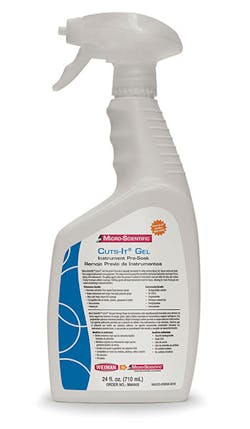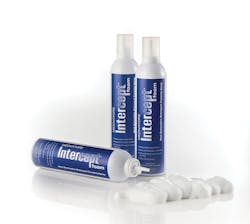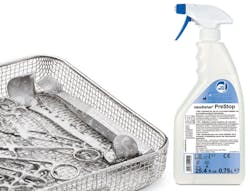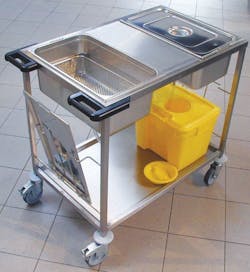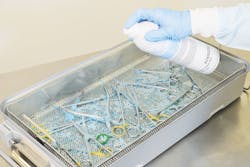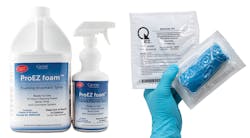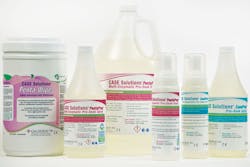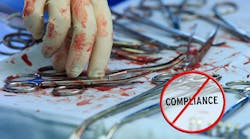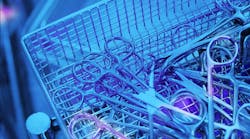Let’s face it – healthcare is a dirty business. The clean and sterile devices and instruments that arrive in the operating room (OR) or other clinical areas for patient procedures typically leave post-procedure covered in residual bioburden, such as blood and tissue. This bioburden becomes harder to remove the longer it remains on an item. Not only can it damage them, if left long enough it can result in stubborn biofilm that can harbor dangerous microbes. Biofilm is challenging – if not impossible to remove. Bacteria within biofilms can be up to 1,000 times more resistant to a given agent (e.g. sterilants, disinfectants and antibiotics) than their counterparts that are not part of a biofilm colony.1 When pieces of this biofilm detach from an instrument or device, they can potentially recolonize elsewhere, spreading infection.
While Central Sterile/Sterile Processing Department (CS/SPD) professionals are seen as those responsible for device and surgical instrument processing, the steps necessary to take dirty items and process them effectively for the next round of procedures start at the point of use (POU). Industry guidelines from the International Association of Healthcare Central Service Materiel Management (IAHCSMM), Association for the Advancement of Medical Instrumentation (AAMI) and the Association of periOperative Registered Nurses (AORN), clearly state that POU pre-cleaning by clinicians or technicians post-procedure is critical to removing bioburden and helping to prevent the formation of biofilm.
While the guidelines state that POU cleaning is a crucial step in effective and safe instrument processing, when speaking with CS/SPD professionals and others, it becomes clear that this step is often skipped, or performed inadequately, resulting in heavily contaminated instruments arriving in the CS/SPD.
In the case of Porter Adventist Hospital in Denver, failure of hospital staff to adequately pre-clean orthopedic and spine surgery tools contributed to inadequate processing and contaminated items being used in procedures, placing approximately 5,800 patients at risk for contracting HIV, hepatitis or surgical site infections (SSI). An investigation of the hospital by The Joint Commission found 129 instances of “incomplete removal of gross surgical contamination” over the course of 13 months.2,3
In a statement to the affected patients, Porter Adventist Hospital cited “a gap in the pre-cleaning process of surgical instruments, prior to manual washing, machine washing, and sterilization.”4
In this article, HPN examines the importance of POU cleaning, why some healthcare staff members inadequately perform it (or neglect it all together) and best practices and products to boost POU cleaning compliance, efficiency and efficacy.
A pressing need and a growing concern
Both clinical areas and the CS/SPD face a tremendous challenge – how to effectively and safely process instruments and devices in the midst of growing case volumes, more complex and difficult to clean instrumentation, and pressures to streamline processes and increase efficiency.
While pre-cleaning at the POU may be viewed by some as an extra, time-consuming step, in reality the process paves the way for greater efficiency in the CS/SPD, which can mean faster turn-around times for instruments and devices back to the OR and other procedural areas.
“If instrumentation is prepped in the OR by OR personnel, it makes the cleaning process in the SPD easier, faster and more efficient,” said Todd Campbell, President, TBJ.
Kevin Anderson, BSN, RN, CSSM, CRCST, CHL, CIS, CER, Clinical Education Coordinator, Healthmark, explains how POU cleaning has only grown in importance with today’s more advanced devices and procedures, stating:
“The process of preparing soiled instruments for return to SPD becomes more important as surgical instrumentation becomes increasingly complex, and all members of the perioperative team feel the pressure to improve efficiency,” said Anderson. “Proper preparation of soiled instruments in the OR can reduce processing time, preserve useful life of expensive instruments and endoscopic equipment, and improve staff safety and SPD quality.”
Time is of the essence
The rationale for POU cleaning comes down to timing – and drying. Think of a dirty dish sitting after a meal. As the food matter remains on the dish and dries it typically becomes much harder to remove, which makes it more challenging to clean. It is a similar situation with an instrument or device – if POU cleaning does not occur, bioburden remains, dries and hardens, presenting a significant challenge to the CS/SPD. Therefore, clinical staff must do their part to pre-clean instruments according to the manufacturer’s instructions for use (IFU).
Darren Dahlin, Director of Clinical Education for Cantel, stresses the need for prompt transport of instruments from clinical areas to the CS/SPD post-procedure, and the importance of keeping instruments moist during this journey, stating:
John Kimsey, National Director, Professional Services, STERIS, has seen very high functioning healthcare facilities where instruments are decontaminated in the CS/SPD within 30 minutes of leaving the OR. But even in these cases, failure to pre-clean post-procedure still complicates the decontamination process. He states:
“Even at 30 minutes though, cement is hard as a rock and bioburden has begun to dry. I’ve also seen instruments sit in backlogs in decontamination for hours, which only increases the difficulty of cleaning. With the increased interest in offsite reprocessing, the delay from OR use to decontamination lengthens due to transportation time, reinforcing the need for POU cleaning.”
Why isn’t POU cleaning done?
Jamie Zarembinski, CCSVP, Clinical Educator, Sterile Processing, Key Surgical, says there is a wide range of compliance on POU cleaning across the U.S., and even those healthcare facilities that perform it have the opportunity “to be better and make process improvements at the departments and facility level.”
The industry guidelines prescribe POU cleaning, and failure to perform it has been linked to infection outbreaks among patients. So why is this critical step being skipped?
“The biggest hurdle here is culture,” said Kimsey. “Our culture has focused on turnaround times and shedding anything that inhibits a scrub tech or circulator from turning the room. The quote ‘we don’t have time for that’ or ‘that is SPD’s job’ shouldn’t be an acceptable answer to a request that AORN and others support as best practice. We should be holding ourselves accountable to finding a process that allows for POU cleaning and efficient room turnovers.”
While O’Brien acknowledges how time constraints in the OR force staff to be efficient and turn rooms quickly to satisfy the C-Suite, he adds that OR staff must play their part in instrument processing, stating:
“It’s important to note that OR staff will push back when presented with the steps required post-use for instrument management due to existing time constraints and the like, but the role OR staff play in the overall instrument reprocessing spectrum is extremely critical. Attention to detail and removal of visible debris during and after cases is a minimum standard that should be in place and accountable. Coordinating the process as a collaborative between sterile processing and end users (OR, et. al.) is the key to developing a successful process.”
- Use pretreatment foams or gels, which are less prone to spill during transport and provide greater assurance that instruments remain moist during unexpected reprocessing delays.
- Use pre-treatment products packaged in a Bag-On-Valve canister to help reduce hand fatigue.
Lena Burgess, CRCST, CIS, CFER, CHL, Manager, Health Safety and Environment, Instrument Processing, STERIS Instrument Management Services (IMS), describes compliance with POU pre-cleaning as cyclic, stating:
“The process, when done consistently, works to decrease residual bioburden on instrumentation. The consistency with which the process is completed is cyclic. When there is a focus on point-of-use care of instrumentation, there is an increase in the process being completed. When the compliance improves and there is a shift in the focus to another area of improvement, the trend is for point of use instrument care compliance to wane.”
Based on Kimsey’s experience in multiple U.S. hospitals, he says POU cleaning is a “50/50 proposition” with orthopedics being the “worst offender of not cleaning or prepping their instruments.” He adds, “other services are perhaps less invasive and thus their instruments are easier to accommodate.”
The number of individuals in the OR and other clinical areas who handle instruments post-procedure during various shifts, and the lack of monitoring around POU cleaning are two factors that can result in low POU cleaning compliance, according to Anderson. He states:
“The incidence and quality of POU care is widely variable between institutions. Not enough facilities are monitoring this process closely. There are a lot of people handling instruments before they go to SPD. The typical facility has circulators, scrubs and first assistants (FA) on multiple shifts. Any of them could be responsible for preparing the instruments at the POU.”
“The most significant issues arise on weekends and after hours when staff is reduced or not available to handle the workload,” said Dahlin.
“When dirty instruments are left sitting for any amount of time, it’s critical they’re covered with a protective pre-treatment spray; preferably an enzymatic with corrosion inhibitors,” Norton added. “Blood soils can start corrosion on some types of metals within 10 minutes and once instruments are compromised, they’re difficult to clean adequately, putting patients at immediate risk.”
Below are some key practices suggested by Certol International’s clinical education manager, Peggy Spitzer:
- Compliance with point of use care will affect scheduling and productivity so management support is essential.
- Deliver training and supplies to all point of use departments coordinated by nurse educators, infection preventionists and sterile processing managers.
- It is critical to routinely wipe off or flush soils DURING surgical and clinical procedures with sterile water and sponges.
- If transport delay is frequently over one hour, coverage with wet towels may not prevent corrosion. Select a point of use treatment spray tested and validated to provide anti-corrosives and effective enzyme action.
- Use OSHA biohazard compliant transport containers with solid sides, bottom and lids.
POU: Tips for making it happen
CS/SPD professionals and others recognize the importance of POU cleaning, so how do they work with the OR, other clinicians and healthcare facility leadership to drive greater compliance with industry guidance?
Establish a policy
Czarnowski says an effective way to drive POU cleaning compliance is to work with leadership to make it hospital policy that OR staff are required to perform.
“That way, when you are speaking to staff you can speak to the hospital’s policy and say this is what we have decided must be done, based upon published standards,” said Czarnowski. “When I joined one facility, POU cleaning was unknown to both the CS/SPD and OR staff. Through hard work and cooperation, we did a complete 180, achieving 100 percent buy-in and compliance.”
Communicate and collaborate
Kimsey recommends creating an awareness of teamwork between the CS/SPD and OR and how “how each step in any process is really a supplier/customer relationship.”
“Lean methodologies support ensuring each step of any process meets the quality output expectations of the next step so that the overall process becomes more efficient,” said Kimsey. “In this sense, the OR is the supplier of a product to SPD as the customer. Expectations of how the OR is to supply the product ‘dirty instruments’ to the SPD is documented and agreed to and then measured for compliance.”
Educate
Anderson says the most important factors of success for POU cleaning compliance are education and accountability. He states:
“Most healthcare institutions already have something like Healthstream in place, which is a program used to deploy mandatory educational materials across an entire institution, or system. This could easily be leveraged to educate staff on the importance of POU care of reusable medical devices (RMD), and the facility’s policy and procedure regarding POU expectations.”
While policy implementation got the ball rolling, it was OR staff education that truly made an impact on POU cleaning compliance in his facility, according to Czarnowski. He leveraged AORN guidelines and worked with front-line OR staff to develop a presentation to educate the OR on proper pre-cleaning.
“When we talk to the OR, a very useful resource is AORN, because it is an organization of their peers,” said Czarnowski. “When you can point to AORN’s perioperative guidelines that say POU cleaning is important than you are speaking from their group to their group. While we created the presentation, OR staff took the lead on educating their team. I felt this was important because I wanted the nurses and techs to hear from their own.”
In 2019, the Association for Professionals in Infection Control and Epidemiology (APIC) published the results of an intensive “train-the-trainer” program emphasizing the importance of pre-cleaning, according to Lynn Burbank, DNP, RN, CRNP, Senior Manager, Infection Prevention, ENT, Gynecology, Surgical, Urology – Endoscopy, Reprocessing Strategy Office, Olympus Corporation of the Americas.
“Results were significant for implementing education as an intervention to facilitate the understanding of the importance of pre-cleaning as a means to prevent infection,” said Burbank.
Implement new technologies and products
There is a wide range of solutions available to help in the pre-treatment of devices and instruments in procedural areas. For example, Zarembinski notes how there have been improvements in pre-treatment products that have increased material compatibility while providing superior performance.
When selecting a POU treatment, Marcia Frieze, CEO of Case Medical, offers the following advice: “Always review the safety data sheet (SDS) to ensure its safety, select pH neutral cleaners to avoid damage to surgical instruments and instrument containers, and ensure the cleaner is free rinsing to prevent residue that may interfere with sterilization or remain on instruments designated as ready for patient use.”
Campbell speaks to solutions available to aid in the transport of dirty instruments to the CS/SPD for processing. He states:
“Specialty transportation carts made specifically for transporting contaminated instruments from the OR to SPD enable the OR to, at the very least, help prevent soiled instrumentation from drying thus making the cleaning process in SPD less difficult.”
Czarnowski offers his advice for POU treatment of flexible endoscopes, which are notoriously hard to clean, stating:
“If I were a super villain and wanted to design a device to transfer disease from one person to another, it would be a flexible endoscope, because it is complicated, hard to clean and delicate. The way we can combat that super villain is to employ conscientious POU cleaning, and a bedside flushing kit is a great place to start.”
Czarnowski says there are a wide range of bedside kits available, which make it easy for technicians to perform the flushing step after use and before the endoscopes are sent to decontamination.
Take it off-site
When offering best practices for POU cleaning compliance, Czarnowski reminds those leading these efforts to incorporate sites using instruments and devices outside of the four walls of the hospital, including ambulatory sites and clinics.
“When it comes to POU cleaning, you have to reach out to ambulatory sites/clinics and make sure they are aware of it and perform it because the instruments may even sit longer than they do within a hospital setting, making bioburden even harder to remove,” said Czarnowski. “The best practice is to travel to those doing the work and bring the information to them – someone has to step up and do that.”
Document and track
As with any process, compliance can slip if a healthcare facility does not have in place a way to document POU cleaning and track it over time. Dahlin points to digital documentation systems that can track and monitor instruments and procedures to alert staff when a procedure is over, allowing the SPD staff to prep for the arrival of soiled instruments, as well as remind the OR staff to complete the pretreatment of the instruments prior to sending them to the processing area.
“Developing an audit tool and committing to auditing POU care compliance can be extremely effective when done correctly,” said Anderson. “Audit results should be monitored, shared, and built into performance reviews to enhance awareness and compliance. It’s important that this is not used to blame, but to drive quality.”




